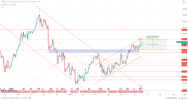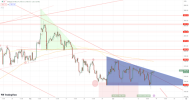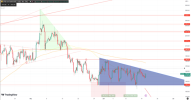Recession in New Zealand, Market Moves in Asia, and Monetary Policy Expectations in Europe and the US
In the Asia-Pacific region, New Zealand experienced a technical recession as its first-quarter gross domestic product (GDP) dropped by 0.1% compared to the previous year. This decline follows a revised 0.7% contraction in the final quarter of 2022. Meanwhile, in Japan, both the Nikkei 225 and the Topix experienced marginal falls, breaking their four-day winning streak. The Nikkei 225 closed at 33,485.49, and the Topix closed at 2,293.97 as the Bank of Japan commenced its two-day monetary policy meeting. In China, the central bank reduced its key medium-term lending rates, and the country released various economic data, including industrial output, retail sales, and house prices.
As European markets prepare for the latest monetary policy decision from the European Central Bank (ECB), they are expected to open with a negative outlook. The ECB is anticipated to raise its benchmark policy rate by 25 basis points during its meeting on Thursday. Moreover, the ECB is likely to emphasize that future rate decisions will be influenced by data, given the prevailing uncertainties affecting inflation and growth prospects.
On the other hand, the Federal Reserve, in its recent announcement, maintained its key borrowing rate within the target range of 5%-5.25%. However, it was the release of the dot plot, representing Fed members' rate projections, that caused market fluctuations. The dot plot revealed the central bank's projection of two more rate hikes, assuming they continue at quarter-point increments. Fed Chairman Jerome Powell indicated that the committee's next meeting in July remains significant, suggesting that a quarter-point hike is not predetermined.
EURUSD
The EUR/USD continued its upward trajectory, achieving its highest daily close in a month above 1.0800, despite the US Dollar's rebound following the hawkish stance of the Federal Open Market Committee (FOMC). Market attention now shifts towards the upcoming European Central Bank (ECB) meeting and forthcoming US data, which have gained significance in light of Fed Chair Powell's statement that the July meeting will be a 'live' one.
On Thursday, the ECB's Governing Council will convene, with expectations of a 25 basis points interest rate hike. The crucial factors for the Euro's performance will be the language used in the statement and the comments made by ECB President Lagarde during the subsequent press conference. It is likely that President Lagarde will reiterate their intention to continue raising rates. However, if the meeting adopts a 'dovish' tone, hinting at a potential pause in rate hikes, the Euro may face downward pressure.
After the Fed meeting, the US dollar staged a recovery as the central bank chose to keep interest rates unchanged but signaled a willingness to pursue further rate hikes. The hawkish stance had an impact on Treasury bonds, leading to their decline, and bolstered the strength of the greenback. Fed Chair Jerome Powell's remark that the July meeting would be a "live meeting" indicated that additional rate hikes remained a possibility. According to the projections released by the FOMC, a majority of its members foresee a total tightening of 50 basis points by the end of the year.
GBPUSD
The Pound Sterling is experiencing a pullback due to the US Treasury bond yields and the possibility of a July rate hike by the Federal Reserve. Mixed data from the previous day is also contributing to the decline. Meanwhile, the UK's GDP grew by 0.2% in April, but industrial production and the Index of Services slumped. The US Federal Open Market Committee has kept the benchmark interest rate unchanged, but the hawkish Fed bias remains due to the upbeat FOMC Economic Projections and Powell's speech. The Fed dot plot indicates two more rate increases in 2023, and July is considered a "live" meeting for a possible rate hike. Soft China data and fears of a slower global economic recovery are weighing on the S&P500 Futures and USD. US Retail Sales for May and other important mid-tier activity data will be crucial for the Fed's decision-making.
GBP/USD performed higher while breaking all the potential resistance levels and now testing the historical level of 1.2680. If the breakout happens then the 1.2760followed by the 1.2800.
JPYUSD
The Japanese yen is facing downward pressure against other currencies due to several factors. The US Federal Reserve's decision to keep interest rates unchanged but hint at future hikes contributes to the bearish sentiment. Additionally, the recent interest rate increases by the Reserve Bank of Australia and the Bank of Canada further strengthen the yen's bearish outlook. Market attention now turns to the upcoming meeting of the Bank of Japan, where it is anticipated that the central bank will maintain its loose monetary policy and yield-curve control without making any changes. BoJ Governor Kazuo Ueda has emphasized the need to sustainably achieve the 2% inflation target, indicating a patient approach to monetary policy. Recent economic data revealed better-than-expected growth in Japan's economy during the January-March quarter, driven by domestic spending and inventory buildup.A recent Reuters poll indicates that over half of the economists surveyed believe the Japanese government and central bank will take action to prevent further decline of the yen if it weakens beyond 145 per U.S. dollar. While the Bank of Japan (BOJ) is expected to maintain its current policy at the upcoming meeting, there is speculation of a possible rollback of easing measures in the future. The impact of a weak yen on BOJ policy is also a concern, as economists suggest that a depreciation beyond 145 per dollar could influence the central bank's decisions. From a technical analysis perspective, the USD/JPY pair is currently trading within a price range as market participants await the Federal Reserve (Fed) meeting and its decision. The pair maintains a significant correlation with the US 10-year Treasury yield, and yesterday's positive movement had an impact on the pair's dynamics. However, it's important to note that upcoming events scheduled for this week could influence the market outlook and potentially lead to changes in the current analysis.
XAUUSD
The Federal Reserve held its monetary policy meeting on Wednesday and maintained the Fed funds rate at 5.0%-5.25%, signaling a pause to its interest-rate hiking cycle for the first time since early 2022 . However, the Fed's Dot Plot chart showed a hawkish outlook, with the terminal rate projection for end-2023 revised upwards to 5.6% from 5.1% in March. This led to the US Dollar and US Treasury bond yields rebounding . Chairman Jerome Powell stated that the Fed will continue to watch how the labor market moves and that the July meeting will be a "live" one, with odds for a 25 bps rate hike next month increasing to around 70% . The Gold price reversed its early bounce and settled near daily lows, with markets closely scrutinizing incoming US economic data to reprice Fed expectations . The European Central Bank is expected to raise key rates by 25 bps, with markets predicting a pause in September .
The gold price is currently showing signs of a potential bearish breakout below the 100-day moving average (100MA) on the daily chart, which has acted as a significant level of support in the past. If the ongoing selling pressure persists and confirms the breakout, the next key support levels to watch are around 1900, followed by a stronger support area in the range of 1870-1860. These levels could serve as the final target for the downward movement.
DAX40
European shares started the day with a decline as the European Central Bank (ECB) was expected to raise borrowing costs later in the day, following the U.S. Federal Reserve's indication of more rate hikes. However, losses were partially offset by an increase in H&M shares, which boosted the overall performance of retailer stocks after reporting positive sales in June, the beginning of its third quarter.
The STOXX 600 index, representing the European market, fell by 0.3%. European retailers experienced a gain of 0.9%, primarily driven by a 5.3% rise in the shares of H&M from Sweden.Later today, the ECB is anticipated to raise the deposit rate by 25 basis points to 3.5%, reaching the highest level in 22 years. The ECB is also expected to leave room for further rate hikes as it continues its efforts to combat persistent inflation, despite the sluggish performance of the eurozone economy.
On Wednesday, the U.S. Federal Reserve chose to keep interest rates unchanged, but signaled the likelihood of at least a 0.5% increase in borrowing costs by the end of this year.
The DAX index price waiting at the 16330 level for the ECB meeting Today for more direction. Investors should closely monitor the next resistance level at 16,800, as it could pose a significant challenge for further upward momentum. On the other hand, if the index experiences a decline, support is expected around the 15,900 level.




